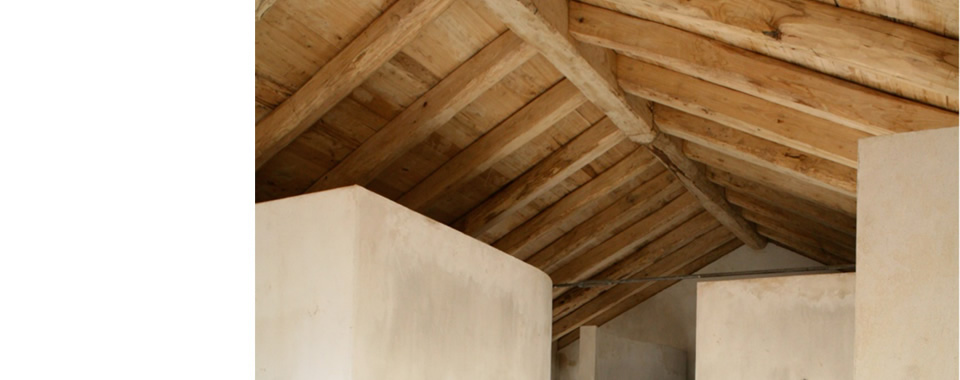

Score - Sustainable Construction in Rural and Fragile Areas for Energy efficiency
Guidelines for Integrated territorial Planning:
Water resource (rain collection, etc)
The following guidelines come from a deep analysis of case studies, norms, and regulations, relating at both national and regional levels. This analysis is summarized in a card that can be downloaded in Spanish language.
In a scenario where water is becoming a very valuable asset, especially in the Mediterranean Area, expense control of potable water is considered a must. The re-using concept is based on the idea of:
- Collecting, filtering and storing the rain water for non potable uses (toilet tanks, washing machine, gardens irrigation, etc)
- Collecting, treating and storing “grey” water (shower, basin) for the same purpose.
Although rain and grey water collecting systems and re-using technology is quite developed in our country, however these kinds of systems are still not spread widely enough.
The implementation of these systems could have evident benefits on both the urban water supplying and especially on the collection, treatment and dumping network of the city, as total water volumes would be greatly reduced. The current consumption in Spain is over 150 liters per person per day, and the percentage of potable water savings could reach 50%. This would suppose a lower impact on existing aquifers, with direct consequences on ground drying, erosion, and desertification. In addition, it would contribute to minimizing the cost of large water supply and treatment infrastructures (dams, reservoirs, sewage treatment plants, etc). Consequently, it would also have a positive impact on coastal and fluvial ecosystems, which currently receive the final spills from the urban water cycle.
Changing water use habits in mediterranean countries would put them in a better position in times of drought, by avoiding the rapid decreases in reservoir levels, and to balance out the sometimes short wet and rainy season.
Despite all of this, the installation of water re-using systems are not specifically named in the Spanish legal frame as a sustainable construction practice, therefore is not an obligation to implement it in the construction industry. The only specific law related to this is a decree that specify the treatment requirements needed before fluids can be re-used and how and when to test them, which is likely to be confusing and therefore not desirable in domestic setting.
A second difficulty concerning the diffusion of this technology is the economical impact. The implementation of water re-using equipment means a 2.000-6.000 € of costs increase per housing unit compared to conventional systems (depending on the project). Therefore, the amortization period for this technology is long, especially for small projects, like single-family residential buildings (15-18 years considering the current price of water per volume unit). These two issues together are the reason why water re-using technology is not regularly included in modern Spanish building.
Easy application of this technology in existing constructions or in restoration/renovation works is also an important aspect to consider talking about the degree of water re-uses. To avoid the possibility of future connections of treated water conduits and potable water ones, different colors and materials should be used.
The diffusion of sustainable works of water re-using systems could be facilitated by the following advices:
- Enacting specific laws and regulations that define this technology as a sustainable construction practice, regulating the minimal treated water volumes in relation with the different sort of projects (housing, commercial, industry, hotels, etc)
- Extending the policy of economic help for this technology, at least in the first phases of diffusion.
- Foster the collecting of rain water from different administrations, and promoting actions for taking advantage of this free resource in public spaces (construction of separating rain/waste draining urban lines, construction of rain tanks for irrigating parks and gardens).
Indication for the Bio-construction Action Plan
Pursuant to the guidelines written above, the criteria/examples for pilot projects to be financed in MED territory, in relation with the specific treated are reported bellow.
These criteria/examples, together with the ones resulting from all the themes of eco-construction tool matrix, will make up a Bio-construction Action Plan for each partner countries.
- Projects for normative/regulations structure adjustment or enacting new specific laws, especially for regional level, aimed to define the water re-using as a valuable practice in building sustainability, specifying the minimum volumes of treated water required.
- Projects for studying the possibilities of implement the water re-using technology in urban public spaces or existing administration buildings.
Possible criteria for MED bio–housing quality certificate
The internationally recognized green building certifications normally have several indications about the water re-using systems. This does not happen for the most common spanish certification system. Nowadays the only current regulation about this theme is the Decree 47/2010 (Basic Procedure for Energetic Efficiency Certification in New Buildings), which has no reference to the water expense control in its articles. Usually these kinds of laws are centered basically in the energetic field, forgetting other main themes such as water consumption, debris managing, etc. We only have minor references in the (CTE) Technical Building Code (separating rain/waste pipelines in residential buildings, point 3.1 of HS-5; individual water saving systems, point 3.6 of HS-4). It isn’t considered necessary that green building certifications should be made more complicated. However we think it would be recommended to include other sustainable practices in certification requirements.
Case studies
- Hotel Monte Málaga, Málaga.
- Abengoa Headquaters (office building), Palmas Altas (Sevilla)
- Rural House Renovation, La Nava (Huelva).
